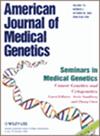Molecular advances, clinical management, and treatment opportunities in RASopathies
IF 2.8
3区 医学
Q2 GENETICS & HEREDITY
American Journal of Medical Genetics Part C: Seminars in Medical Genetics
Pub Date : 2022-12-21
DOI:10.1002/ajmg.c.32026
引用次数: 0
Abstract
RASopathies are the quintessential paradigm of the complex relationship between genetic heterogeneity and clinical variability: lumping multiple genes as cause of one and the same syndrome versus splitting multiple phenotypes caused by one and the same gene. RASopathies are a group of syndromes involving development and growth, caused by pathogenic germline variants in a group of genes, mostly enhancing signaling through the RAS-MAPK cascade, a master regulator of cell proliferation, differentiation and death (Aoki & Matsubara, 2013; Aoki, Niihori, Inoue, & Matsubara, 2016). Of note, somatic mutations of these genes also cause cancer (Dunnett-Kane et al., 2020). In a balanced situation, where the status of genes and the conformation of the respective protein products vary inside acceptable limits, the resulting phenotype is normal. Strong variations at the germinal level will cause the demise of the developmental project (spontaneous abortion); mild variations will cause one or other of the RASopathies; strong somatic variations will cause cancer. The present issue of Seminars in Medical Genetics deals with RASopathies, a family of syndromes that over the years accrued around the prototype of the family, the Noonan syndrome (NS), the mildest of all, running in some families as an autosomal dominant trait (Aoki, Niihori, Narumi, Kure, & Matsubara, 2008). The others that followed, such as cardiofaciocutaneous syndrome (CFCS) (Roberts et al., 2006; Narumi et al., 2007) and Costello syndrome (CS) (Aoki et al., 2005; Niihori et al., 2011), have generally a more severe phenotype and present as sporadic cases, assumed to be caused by new heterozygous variants of genes yet to be discovered (Tartaglia, Cotter, Zampino, Gelb, & Rauen, 2003). In the early days, lack of knowledge of these genes led to a controversy among authors on whether newly reported syndromes were authentically distinct conditions or simply phenotypic variants of NS. Typical in this respect was the much debated distinction between NS and CFCS (Fryer, Holt, & Hughes, 1991; Neri, Zollino, & Reynolds, 1991; Verloes et al., 1988; Ward, Moss, & McKeown, 1994; Wieczorek, Majewski, & Gillessen-Kaesbach, 1997), not devoid of practical implications. In the perspective of genetic counseling, while the estimation of the recurrence risk was not an issue, given that both syndromes were firmly thought to be of autosomal dominant heritability, the prediction of clinical manifestations was a problem since mild (NS) and severe (CFCS) phenotypic features could coexist in the same family if the two syndromes were etiologically one and the same (Leichtman, 1996). The dilemma was eventually solved by the discovery, in succession: (a) that NS is caused by mutation of the PTPN11 gene (Tartaglia et al., 2001); (b) that none of selected cases of CFCS tested positive for this mutation (Ion et al., 2002); (c) that cases of CFCS are caused by mutations of either BRAF, MEK1, or MEK2 genes (Niihori et al., 2006; Nowaczyk et al., 2014; Roberts et al., 2006). These discoveries placed the RAS-MAPK signaling pathway at the center of further investigations leading to the identification of many other genes whose mutations account for additional variants of the NS phenotype belonging to the family of RASopathies (Hebron, Hernandez, & Yohe, 2022). With most genotype–phenotype issues now solved (Cordeddu et al., 2015; Razzaque et al., 2007; Schubbert et al., 2006; Tartaglia et al., 2007; Yamamoto et al., 2015), we thought it would be useful to recapitulate the knowledge accumulated so far as basis for an informed approach to the treatment of RASopathies: from currently available clinical tools and management strategies to the development and use of effective therapies. With this goal in mind, we invited expert authors to review different aspects of RASopathies, collected in the 13 articles that follow this introduction. The first article provides a broad clinical overview of RASopathies (Zenker, pp. 414–424) followed by a detailed updating of their DOI: 10.1002/ajmg.c.32026RASopathies的分子进展、临床管理和治疗机会
本文章由计算机程序翻译,如有差异,请以英文原文为准。
求助全文
约1分钟内获得全文
求助全文
来源期刊
CiteScore
7.00
自引率
0.00%
发文量
42
审稿时长
>12 weeks
期刊介绍:
Seminars in Medical Genetics, Part C of the American Journal of Medical Genetics (AJMG) , serves as both an educational resource and review forum, providing critical, in-depth retrospectives for students, practitioners, and associated professionals working in fields of human and medical genetics. Each issue is guest edited by a researcher in a featured area of genetics, offering a collection of thematic reviews from specialists around the world. Seminars in Medical Genetics publishes four times per year.

 求助内容:
求助内容: 应助结果提醒方式:
应助结果提醒方式:


